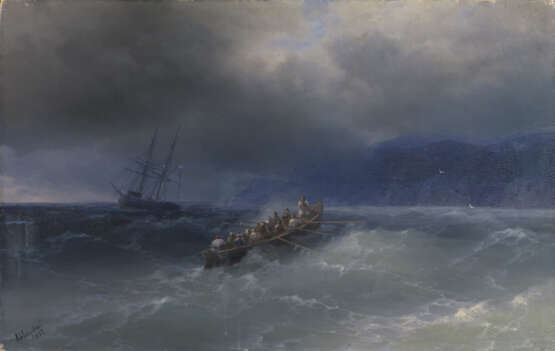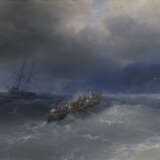AIVAZOVSKY, IVAN (1817-1900) Storm over the Black Sea , signed and dated 1893, also further signed on the reverse.
29.11.2017 11:30UTC +00:00
Classic
Prix de départ
200000GBP £ 200 000
| Auctioneer | MacDougall Arts Ltd. |
|---|---|
| Lieu de l'événement | Royaume-Uni, London |
| Commission | 27 % |
Archive
La vente aux enchères est terminée. Vous ne pouvez plus enchérir.

ID 12126
Lot 62* | AIVAZOVSKY, IVAN (1817-1900) Storm over the Black Sea , signed and dated 1893, also further signed on the reverse.
Valeur estimée
£ 200 000
Provenance: Acquired in 1926 by the grandfather of the previous owner.
Private collection, Armenia.
The Russian Sale, Sotheby’s London, 19 May 2005, lot 8.
Private collection, USA.
Authenticity of the work has been confirmed by the expert V. Petrov.
Literature: G. Caffiero, I. Samarine, Light, Water and Sky. The Paintings of Ivan Aivazovsky, London, Alexandria Press, 2012, p. 239, pl. 172, illustrated; p. 320, No. CS-1893-009, illustrated and listed.
Ivan Aivazovsky, the unrivalled master in the depiction of shipwrecks and stormy seas, spent his entire life in search of fresh subjects and motifs that would capture both the majesty and the menace of the elements on his canvasses. Prominent among them is the subject of shipwreck survivors, which first appeared in his work in the 1840s – a theme that would become present in the many leading works of the greatest Russian seascape painter. Painted in 1893, Storm over the Black Sea, offered for sale, is a fine example of the mature artist’s interpretation of the subject.
Aivazovsky seems to have explored to the limit the spectacular yet simultaneously tragic phenomenon of the shipwreck. Often, his aim was to heighten the emotional tension in his compositions. As he later wrote: “I frequently painted shipwrecks, but they were seen only in the distance by viewers who had to imagine in their heart the horrors unleashed within the ship as her fracturing wooden walls were destroyed by the waves...”
The artist felt a special excitement in suggesting that the viewers should work out for themselves the ending to a situation. In case of the Storm over the Black Sea, he placed a boat on the crest of a wave right in the centre, with a handful of people on it from the sinking ship in the background, heading towards the gloomy rocky shore on the right side of the painting. This device of understatement, often used by the artist, when combined with virtuoso effects of colour and light could unfailingly be relied on to impart an emotional charge to the scene.
The pivotal idea in Aivazovsky’s artistic disposition is that of the boundlessness of nature and its immense power. The master’s late work becomes increasingly allegorical, and the might and power of nature are contrasted with the weakness and vulnerability of human life. Light takes on a special conceptual significance. For Aivazovsky, light is a symbol of life, hope and faith, a symbol of the eternal; so, in the offered canvas, the blessed beam of light, breaking through heavy black clouds, just above the boat with the troubled people seems to pave the way for salvation.
In the Storm over the Black Sea offered for sale, as in many other works from the same period (The Survivor, 1892; Among the Waves, 1898; “Empress Maria” During the Storm, 1892), light seems to beam down from some invisible source. Accordingly, after meeting with Aivazovsky in Novy Nakhichevan two years after the master had created the presented canvas, Martiros Saryan identified his main artistic principle: “No matter how terrible the storm that we have seen in one of his pictures, at the top of the canvas there will always be a ray of light breaking through the mass of forbidding clouds; it may be tenuous and faint, yet it is the herald of salvation... It is this, the Light, that encompasses the meaning of all the storms that the artist has painted.” The artist remained true to this principle throughout his life, and Storm over the Black Sea is the finest testament to that.
| Adresse de l'enchère |
MacDougall Arts Ltd. 33 St James’s Square SW1Y 4JS London Royaume-Uni | ||||||||||||||
|---|---|---|---|---|---|---|---|---|---|---|---|---|---|---|---|
| Aperçu |
| ||||||||||||||
| Téléphone | +44 20 7389 8160 | ||||||||||||||
| Téléphone | +7 495 799 4683 | ||||||||||||||
| Fax | +44 (0) 20 7389 8170 | ||||||||||||||
| Commission | 27 % | ||||||||||||||
| Conditions d'utilisation | Conditions d'utilisation | ||||||||||||||
| Heures d'ouverture | Heures d'ouverture
|



